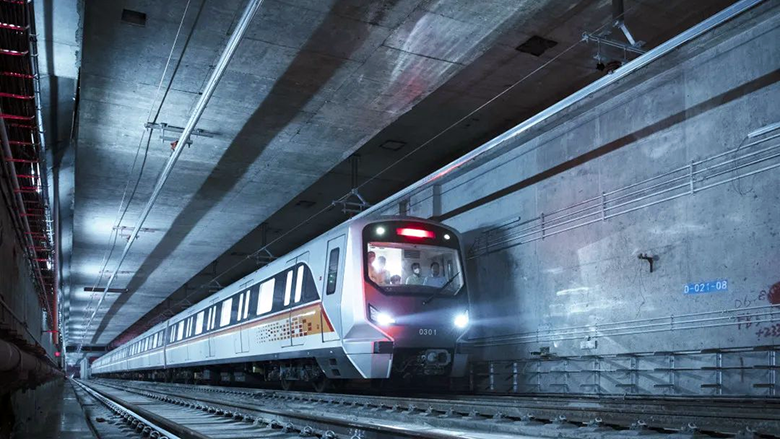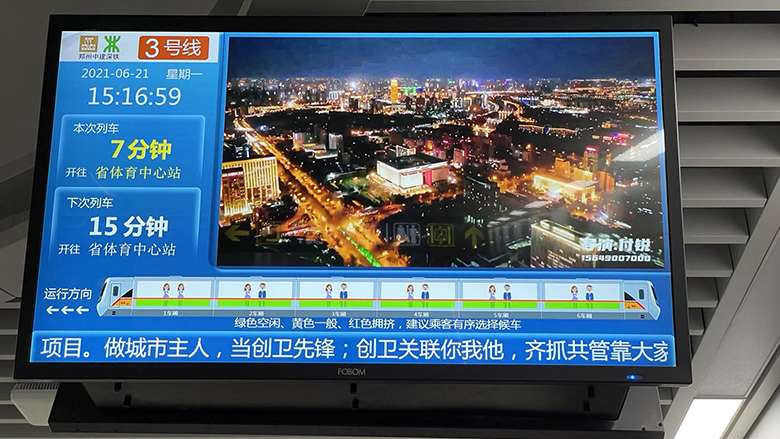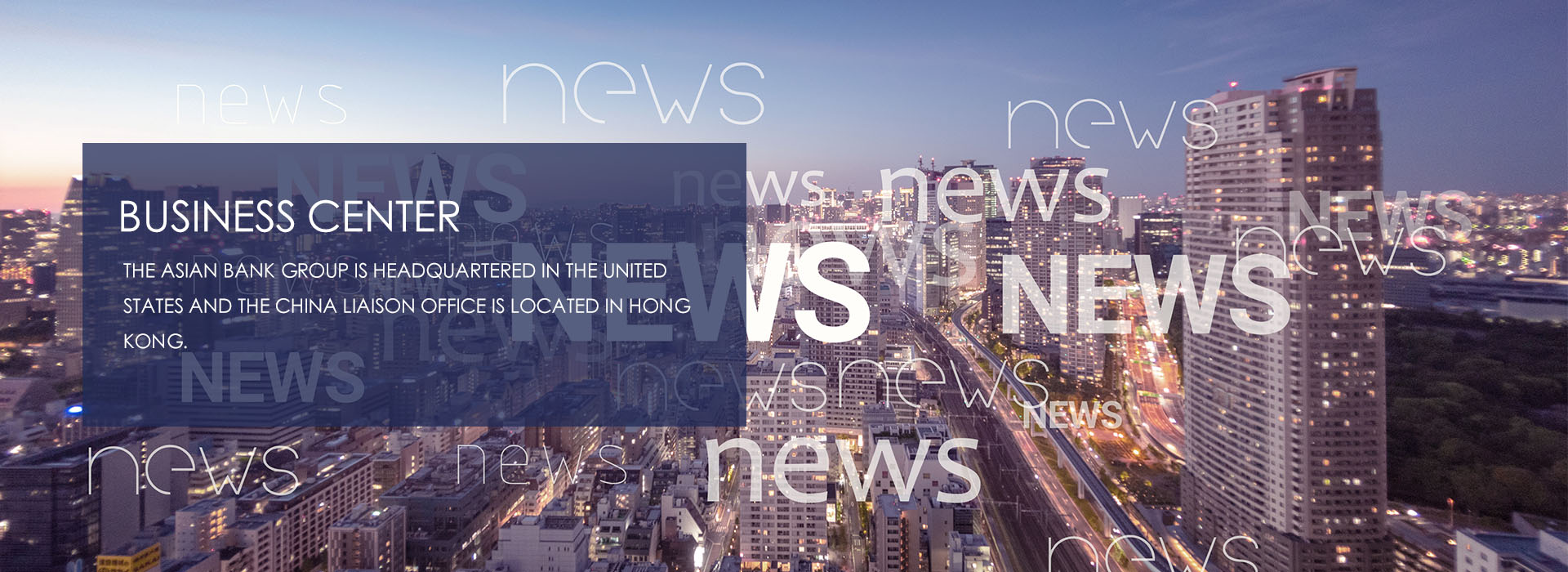challenge
In 2014, the urban area of Zhengzhou, with a population of 5.2 million, saw a sharp rise in vehicle traffic due to rapid urban development. Traffic congestion is so severe that it affects the city's livability. During rush hours, the speed of travel on main roads in the city center drops below 18 kilometers. Rising vehicle ownership and declining bus speeds led to a decrease in bus ridership, which accounted for less than 13.6 percent of total trips. Worsening traffic conditions also increase air pollution and greenhouse gas emissions.

zhengzhou Metro Line 3 in operation (provided by Zhengzhou Zhongjianshen Rail Transit Co., LTD.)
To help Zhengzhou residents improve their transportation conditions, the World Bank supported the construction of Metro Line 3. It is an urban rail line with a total length of 25.2 km, connecting Zhengzhou's urban center with northwest and southeast areas. Special attention is paid to the integration of rail transit with the transportation network of buses, taxis, non-motorized vehicles and parking facilities, and to the integration of accessibility and gender considerations into the design of the stations. Using public-private partnership (PPP), the project contracted an experienced urban rail operator and mobilized a total of $809 million in private investment. The project includes a technical assistance sub-project under the theme of "Transit Oriented Development" (TOD) to provide policy advice to Zhengzhou and develop a TOD plan for Metro Line 3.
In 2021, the project achieved 33,960 tons of carbon dioxide reduction.
The project is in line with the World Bank's Country Partnership Framework for China's goal of "promoting green development", in particular "promoting low-carbon transport and urban development". It is estimated that the project achieved 33,960 tons of CO2 reduction in 2021.
Line 3 provides high-quality and low-carbon travel services for Zhengzhou residents. In June 2021, six months after it was put into operation, Line 3's daily ridership reached 140,000. In the first half of 2021, Zhengzhou had seven subway lines in operation, accounting for 43.7 percent of all public transportation ridership in Zhengzhou. In contrast, Zhengzhou had only two subway lines in operation in 2017, with ridership accounting for only 18 percent of the total bus traffic.
A survey of Line 3 passengers in May 2021 showed that user satisfaction reached 92.7%; 45.1 per cent of passenger households owned cars and could have chosen private transport.
Bus travel times have been significantly reduced. For example, before the opening of Line 3, it took 65 minutes by bus from the provincial Orthopedic Hospital to Erqi Square, but now it takes only 25 minutes by Line 3.
All stations of Line 3 are equipped with straight ladders, ramps and blind lanes to ensure accessible access for all passengers. Each train has two priority carriages for women, and 17 stations have maternity rooms for breastfeeding.
Ladies Priority Carriage (Yang Yi/World Bank)
Bus routes have been restructured to provide transfer facilities between metro and buses, taxis and bicycles to ensure the integration of multiple transport modes.
Shared bikes for multi-mode integration (provided by Zhengzhou China Construction Shenzhen Rail Transit Co., LTD.)
In addition, the project supported the holding of eight seminars on urban rail transit planning, design and financing, and provided training for 1,392 staff members of the Zhengzhou Rail Transit Company and related transportation departments.
The TOD suggestions put forward by the technical assistance project provided the following two policy documents for Zhengzhou Municipal government: "Guidelines for the Comprehensive Development and Construction of Land adjacent to Zhengzhou Rail Transit Section (site) and Stations along the Line" and "Opinions on Further Accelerating the Development of Rail Transit".
Line 3 was completed as planned despite the COVID-19 outbreak. During the period of limited personnel movement due to the epidemic, the project mobilized workers from neighboring provinces to construct the project, and effective epidemic prevention measures were taken at the construction site. After being put into operation, Line 3 introduced infrared thermometers, ultraviolet sterilizers and other equipment, which enhanced citizens' confidence in the travel guarantee of the subway system.
Contribution from the World Bank Group
The IBRD has provided a loan of US $250 million to support the construction of Line 3 and has provided technical assistance to government agencies such as Zhengzhou's Finance Bureau, Planning Bureau, Land and Land Administration, and Transportation Bureau, as well as rail transit companies.
The project partnered with the Global Infrastructure Fund (GIF), a multi-donor trust fund managed by the World Bank, to advise Zhengzhou on PPP transactions for Line 3. This cooperation has played an important role in ensuring that Zhengzhou implements a well-structured PPP project with appropriate risk allocation. The project's PPP arrangement successfully mobilized a total of $809 million in private capital and brought in private sector expertise in urban rail transit operations.
Looking to the future
With various COVID-19 containment measures in place, the ridership of Line 3 has steadily increased. Zhengzhou is continuing to build new urban rail lines, with plans to build 11 lines with a total length of 326 kilometers by 2025, making public transport the backbone of the city's transportation system. Rail transit will greatly promote the decarbonization of Zhengzhou's transportation industry. The best practices of the Line 3 project in terms of multi-modal integration, accessibility and gender considerations have also been replicated in Zhengzhou's new subway line.
The beneficiary

Zhang Sai, a passenger on Line 3, said, "Compared with other subway lines in Zhengzhou, Line 3 is more high-tech and user-friendly. For example, the platform information screen shows how crowded each carriage is, so you know which carriage is not too crowded."
An information screen showing how crowded each carriage is (Yang Yi/World Bank)
"Line 3 runs through several of Zhengzhou's most densely populated districts, effectively easing traffic congestion on the road and promoting green travel in the city," said Yu Chenchen, from the planning and operation department of Zhengzhou Zhongjianshen Railway.









